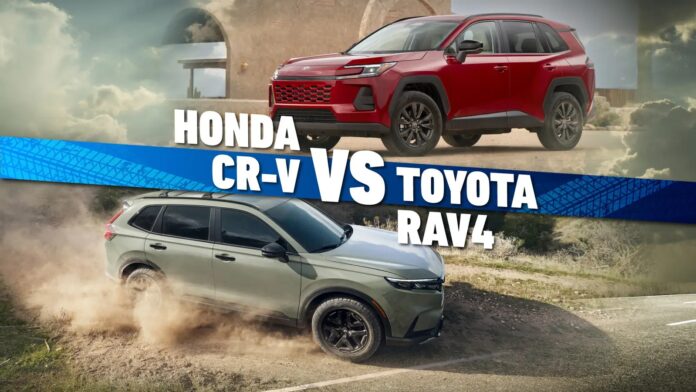Choosing between the 2025 Honda CR-V and the 2025 Toyota RAV4 means selecting from two consistently excellent compact SUVs. Deciding between them is akin to throwing a stone and trying to hit the ocean – it’s difficult to miss! Both are pillars of the compact SUV segment, offering reliability, strong resale value, and modern technology. However, they adopt slightly different approaches and may appeal to different buyers.
The RAV4 enters 2025 with minimal changes, maintaining its established recipe of practicality and Toyota’s solid reputation. Conversely, the CR-V boasts noticeable refinements, new hybrid options, and Honda’s polished driving experience. This comparison aims to clarify which model best suits your needs.
Styling: RAV4 vs. CR-V
The RAV4 has never been a trendsetter, but its recent shift toward a more rugged, chiseled SUV look has proven effective. The 2025 Toyota RAV4 retains its upright stance, bold bodywork, and large windows, prioritizing function over flashy design. It leans into the adventure aesthetic considerably more than the CR-V.
The CR-V prioritizes refinement over style, featuring clean lines, a mature profile, and an exterior conveying practical sophistication rather than attempting to look cool. It’s a testament to creating a great compact SUV without prioritizing appearance.
If you desire an SUV that emphasizes outdoor adventure, the RAV4 is a strong contender. However, if you prefer a composed, tasteful, and mature look, the CR-V might be more appealing.
Performance: Practicality vs. Refinement
The standard 2025 RAV4 uses a 2.5-liter four-cylinder engine producing 203 horsepower, paired with an eight-speed automatic. While competent, it isn’t particularly exciting – Car & Driver notes its engine and transmission can feel “workaday.” Toyota has reduced the availability of its more off-road-focused trims (Adventure/TRD Off-Road) for 2025.
The CR-V offers a 1.5-liter turbocharged four-cylinder (190 hp) for gasoline models, and a refined hybrid variant (Sport line) that elevates the driving experience. The hybrid CR-V receives high praise for smoothness, ride comfort, and interior refinement.
While the RAV4’s bolder SUV appearance might appeal to those seeking raw capability or off-road capabilities, the CR-V excels in on-road comfort, refinement, and smooth transitions.
Interior: Tech, Comfort, and Usability
The CR-V stands out with its spacious cabin, high-quality materials, and excellent ergonomics. It offers generous rear legroom (41 inches) and up to 76.5 cubic feet of cargo space with the rear seats folded. The hybrid version maintains most of that space while enhancing the overall feel.
The RAV4’s cabin is practical and well-thought-out, though you may want to step up to a higher trim level to appreciate the materials and finishes. It boasts very good cargo space, and the large windows improve visibility.
If interior aesthetics, comfort, and tech integration are your priorities, the CR-V takes the lead. If you prioritize rugged utility and broader support (particularly in higher trims), the RAV4 remains a worthy choice.
Comfort and Ride Quality
The RAV4 emphasizes comfort and utility; it rides well, offers ample storage, and provides a solid overall feel. However, it prioritizes everyday competence over driving thrills.
The CR-V adopts a more refined approach – reviewers report a smooth ride, a quiet cabin, and handling tuned for typical daily use rather than an exhilarating experience. If you regularly transport family, passengers, or cargo, the CR-V may provide a more composed ride. Those who value a higher seating position and a more pronounced “SUV character” might prefer the RAV4.
Fuel Economy: Efficiency and Options
Fuel economy varies depending on the powertrain you choose. The gasoline-only RAV4’s 2.5 L achieves respectable ratings (mid-30s mpg) but doesn’t lead the class. The RAV4 hybrid significantly improves fuel economy.
The CR-V hybrid (Sport, Sport-L, Sport Touring trims) receives considerable praise; Car & Driver reports combined ratings of approximately 40 mpg for FWD and 37 mpg for AWD in the hybrid CR-V. This makes it a very efficient option in the compact SUV space.
If maximizing fuel economy while retaining SUV functionality is your goal, the CR-V hybrid is a smarter buy. If you opt for a gasoline-only RAV4, be prepared to sacrifice some efficiency for simplicity and lower upfront costs.
Safety and Reliability
Both models come from manufacturers known for their reliability and resale value. The RAV4 is often considered a benchmark for practicality and durability. The CR-V also boasts strong consumer ratings and reliability indicators.
Safety features are well-covered across both lines, and driver-assist technology is standard or widely available. Ultimately, either model is a safe choice, with both compact SUVs earning 5-star ratings from the NHTSA.
Why the 2025 RAV4 Might Be the Better Buy
The 2025 Toyota RAV4 continues to excel at what it has always done best – appealing to a broad range of buyers. Its strong brand reputation, proven reliability, and excellent resale value make it a very safe choice in the compact SUV segment. It’s the SUV you buy when you want a vehicle that simply works, year after year, without issues.
Utility is another RAV4 strength. With generous cargo space, easy-folding rear seats, and large windows offering excellent visibility, it’s well-suited for families and commuters. Even in lower trims, the RAV4 delivers a comfortable, upright seating position and a sense of rugged practicality that is difficult to fault.
Simplicity is also valuable. The RAV4’s standard gas engine is straightforward—less complex, fewer moving parts, and potentially lower upfront costs compared to hybrid competitors. Its styling also leans into the SUV aesthetic more than many rivals.
Why the 2025 CR-V Might Be the Better Buy
The 2025 Honda CR-V takes a more refined approach, offering a more sophisticated driving experience with a smoother ride, quieter cabin, and an interior that surpasses expectations for its price. Honda’s engineers focused on comfort and composure, resulting in an SUV that makes every trip relaxed and easy.
Efficiency is a significant win for the CR-V, especially the hybrid model, which delivers excellent fuel economy without compromising power or practicality. It’s a smart balance that keeps running costs low while maintaining the space and flexibility that make compact SUVs so popular.
The CR-V excels in the basics: supportive seats, clean ergonomics, and a usable, well-shaped cargo area. Everything feels thoughtfully designed.
Verdict: Two Great Compact SUVs, Two Slightly Different Priorities
Choosing between the 2025 Toyota RAV4 and the 2025 Honda CR-V comes down to your priorities. If you want a rugged, proven, and broadly utilitarian SUV, the RAV4 is a terrific choice. If you prioritize refinement, better technology and comfort, and a more efficient hybrid drivetrain, the CR-V arguably delivers more value for your dollar.
Both models have dominated the segment for years, and whichever you choose, you’re getting one of the best values in the compact SUV market today.























